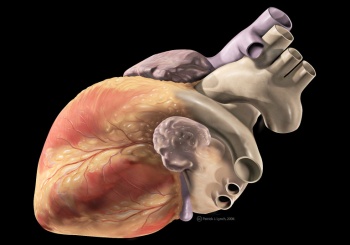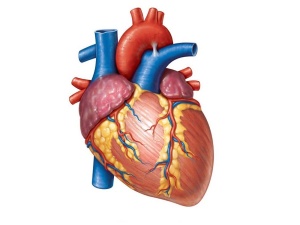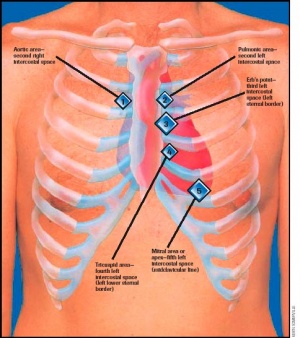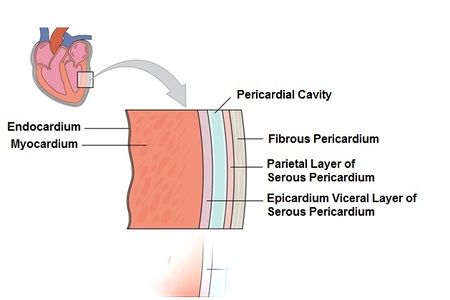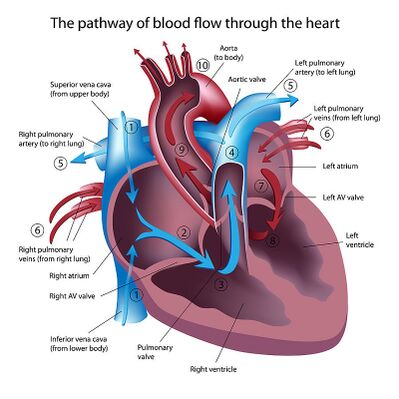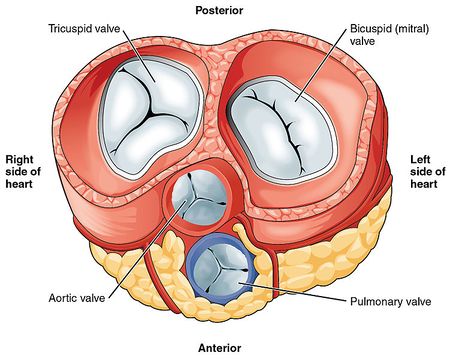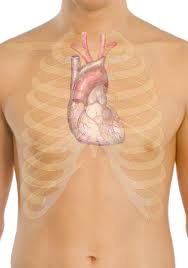Anatomy of the Human Heart: Difference between revisions
No edit summary |
No edit summary |
||
| Line 5: | Line 5: | ||
</div> | </div> | ||
== Introduction == | == Introduction == | ||
[[File:Heart 2.jpg|350x350px|right|frameless]]The heart is a muscular organ that serves to collect deoxygenated [[Blood Physiology|blood]] from all parts of the body, carries it to the [[Lung Anatomy|lung]]<nowiki/>s to be oxygenated and release carbon dioxide. Then, it transports the oxygenated [[blood]] from the lungs and distributes it to all the body parts<ref name=":2">Kenny, WL,Wilmore, JH, Costill, DL. Cardiovascular System and its Control. In Physiology of Sport and Exercise, 5rdedn. Human Kinetics, 2011. 140-150.</ref> | [[File:Heart 2.jpg|350x350px|right|frameless]] | ||
[[File:Human-heart-diagram.jpg|right|frameless]] | |||
The heart is a muscular organ that serves to collect deoxygenated [[Blood Physiology|blood]] from all parts of the body, carries it to the [[Lung Anatomy|lung]]<nowiki/>s to be oxygenated and release carbon dioxide. Then, it transports the oxygenated [[blood]] from the lungs and distributes it to all the body parts<ref name=":2">Kenny, WL,Wilmore, JH, Costill, DL. Cardiovascular System and its Control. In Physiology of Sport and Exercise, 5rdedn. Human Kinetics, 2011. 140-150.</ref> | |||
* The heart pumps around 7,200 litres of blood in a day throughout the body<ref>[https://www.inovaheart.org/upload/docs/Healthcare%20Services/Heart%20and%20Vascular/fast-facts-about-the-heart.pdf Inovqheart Heart Available from: https://www.inovaheart.org/upload/docs/Healthcare%20Services/Heart%20and%20Vascular/fast-facts-about-the-heart.pdf]</ref>. | * The heart pumps around 7,200 litres of blood in a day throughout the body<ref>[https://www.inovaheart.org/upload/docs/Healthcare%20Services/Heart%20and%20Vascular/fast-facts-about-the-heart.pdf Inovqheart Heart Available from: https://www.inovaheart.org/upload/docs/Healthcare%20Services/Heart%20and%20Vascular/fast-facts-about-the-heart.pdf]</ref>. | ||
* The heart is situated at the centre of the chest and points slightly towards the left. | * The heart is situated at the centre of the chest and points slightly towards the left. | ||
| Line 45: | Line 47: | ||
</ref>: | </ref>: | ||
[[File:Heart layers.jpg|450x450px|right|frameless]] | [[File:Heart layers.jpg|450x450px|right|frameless]] | ||
# | # Epicardium - the outer layer of the wall of the heart and is formed by the visceral layer of the serous pericardium. | ||
2. Myocardium - the muscular middle layer of the wall of the heart and has excitable tissue and the conducting system. It is composed of three discernable layers of muscle that are seen predominantly in the left ventricle and inter-ventricular septum alone. It includes: | |||
* A subepicardial layer | * A subepicardial layer | ||
* A middle concentric layer | * A middle concentric layer | ||
| Line 52: | Line 54: | ||
The rest of the heart is composed mainly of the subepicardial and subendocardial layers. | The rest of the heart is composed mainly of the subepicardial and subendocardial layers. | ||
3. Endocardium - the innermost layer of the heart is formed of the endothelium and subendothelial connective tissue | |||
=== Structure and Function === | === Structure and Function === | ||
Revision as of 12:54, 17 July 2021
Original Editor - Uchechukwu Chukwuemeka
Top Contributors - Uchechukwu Chukwuemeka, Lucinda hampton, Kim Jackson, George Prudden, Joao Costa, Sai Kripa, Admin and Adam Vallely Farrell
Introduction[edit | edit source]
The heart is a muscular organ that serves to collect deoxygenated blood from all parts of the body, carries it to the lungs to be oxygenated and release carbon dioxide. Then, it transports the oxygenated blood from the lungs and distributes it to all the body parts[1]
- The heart pumps around 7,200 litres of blood in a day throughout the body[2].
- The heart is situated at the centre of the chest and points slightly towards the left.
- On average, the heart beats about 100,000 times a day, i.e., around 3 billion beats in a lifetime.
- The average male heart weights around 280 to 340 grams (10 to 12 ounces). In females, it weights around 230 to 280 grams (8 to 10 ounces). Infants heart - about a thirtieth of total body weight[3]
- An adult heart beats about 60 to 80 times per minute, and newborn babies heart beats faster than an adult which is about 70 to 190 beats per minute.
It is important to note that, the blood pumped by the heart also circulates many other important substances[1][4] such as:
- Nutrients from digestion are collected from the small intestine and pumped through the circulatory system to be delivered to all cells of the body.
- Hormones are produced from one type of tissues and distributed to all cells of the body. The circulatory system carries waste materials (salts, nitrogenous wastes, and excess water) from cells to the kidneys, where they are extracted and passed to the bladder.
- The pumping of interstitial fluid from the blood into the extracellular space is an important function of the heart. Excess interstitial fluid is then returned to the circulatory system via the lymphatic system.
Anatomy[edit | edit source]
The heart has a somewhat conical form and is enclosed by the pericardium. It is positioned posteriorly to the body of the sternum with one-third situated on the right and two-thirds on the left of the midline. The heart measures 12 x 8.5 x 6 cm and weighs ~310 g (males) and ~255 g (females)
Relations
- Anteriorly: the body of the sternum, and adjoining costal cartilages; left lung, and pleura (apex)
- Posteriorly: oesophagus, descending thoracic aorta, azygos, hemiazygos veins, and thoracic duct
- Superficially : bifurcation of the main pulmonary trunk
- Inferiorly: diaphragm
- Laterally: lungs, pleura[5]
Layers of the Heart Walls[edit | edit source]
The heart wall consists of three layers enclosed in the pericardium[1][4][6]:
- Epicardium - the outer layer of the wall of the heart and is formed by the visceral layer of the serous pericardium.
2. Myocardium - the muscular middle layer of the wall of the heart and has excitable tissue and the conducting system. It is composed of three discernable layers of muscle that are seen predominantly in the left ventricle and inter-ventricular septum alone. It includes:
- A subepicardial layer
- A middle concentric layer
- A subendocardial layer.
The rest of the heart is composed mainly of the subepicardial and subendocardial layers.
3. Endocardium - the innermost layer of the heart is formed of the endothelium and subendothelial connective tissue
Structure and Function[edit | edit source]
The heart is subdivided by septa into right and left halves, and a constriction subdivides each half of the organ into two cavities, the upper cavity being called the atrium, the lower the ventricle. The heart, therefore, consists of four chambers:
- right atrium
- left atrium
- right ventricle
- left ventricle[5].
The right atrium receives deoxygenated blood from the entire body except for the lungs (the systemic circulation) via the superior and inferior vena cavae. Also, deoxygenated blood from the heart muscle itself drains into the right atrium via the coronary sinus. The right atrium, therefore, acts as a reservoir to collect deoxygenated blood. From here, blood flows through the tricuspid valve to fill the right ventricle, which is the main pumping chamber of the right heart.
The right ventricle pumps blood through the right ventricular outflow tract, across the pulmonic valve, and into the pulmonary artery that distributes it to the lungs for oxygenation. In the lungs, the blood oxygenates as it passes through the capillaries, where it is close enough to the oxygen in the alveoli of the lungs. This oxygenated blood is collected by the four pulmonary veins, two from each lung. All four of these veins open into the left atrium that acts as a collection chamber for oxygenated blood. As with the right atrium, the left atrium passes the blood onto its ventricle both by passive flow and active pumping. Oxygenated blood thus fills the left ventricle, passing through the mitral valve. The left ventricle is the main pumping chamber of the left heart, then pumps, sending freshly oxygenated blood to the systemic circulation through the aortic valve. The cycle is then repeated all over again in the next heartbeat.
All four valves of the heart mentioned below have a singular purpose: allowing forward flow of blood but preventing backward flow.[7]
Heart Valves[edit | edit source]
The heart has the Four valves.
Pulmonary Valve - The opening into the pulmonary trunk is closed by the pulmonary valve, which consists of three semilunar cusps with free edges projecting upward into the lumen of the pulmonary trunk thus prevents the backflow of blood as it is pumped from the right ventricle to the pulmonary artery. The cusps are named the left, right and anterior semilunar cusps, relative to their fetal position. Each cusp forms a pocket-like sinus; a dilation in the wall of the initial portion of the pulmonary trunk.[6]
Tricuspid Valve - The right atrioventricular opening is closed during ventricular contraction by the tricuspid valve (right atrioventricular valve) thus prevents the backflow of blood as it is pumped from the right atrium to the right ventricle. It’s named tricuspid valve because it made up of three cusps or leaflets. The naming of the three cusps, the anterior, septal, and posterior cusps, is based on their position in relation to the right ventricle.
Aortic Valve - The opening from the left ventricle into the aorta is closed by the aortic valve thus prevents the backflow of blood as it is pumped from the left ventricle to the aorta. It consists of three semilunar cusps with the free edge of each projecting upward into the lumen of the ascending aorta. Between the semilunar cusps and the wall of the ascending aorta are pocket-like sinuses-the right, left, and posterior aortic sinuses. The right and left coronary arteries emanates from the right and left aortic sinuses; Thus, the posterior aortic sinus and cusp are sometimes called noncoronary sinus and cusp.
Mitral Valve - The left atrioventricular orifice opens into the posterior right side of the superior part of the left ventricle. It is closed during ventricular contraction by the mitral valve (left atrioventricular valve), which is also referred to as the bicuspid valve as it has two cusps; the anterior and posterior cusps. It prevents the backflow of blood as it is pumped from the left atrium to the left ventricle and are continuous with each other at the commissures.[6][8]
Conducting System of Heart[edit | edit source]
The Conducting system is made up of myocardium. It is specialized for initiation and conduction of the cardiac muscle. Our heart beats as a result of the generation and conduction of electrical impulses. If we talk about cardiac conduction rate, it is the rate at which the heart conducts electrical impulses. These impulses cause the heart to contract and then relax. There are 6 conducting systems of heart namely,
- Sinu-artrial node or SA node
- Atrio-ventricular node or AV node
- Atrio-ventricular bundle or AV bundle or bundle of His
- The right branch of AV bundle
- The left branch of AV bundle
- The purkinje fibers
- Pacemaker impulse generation-The first step of cardiac conduction is impulse generation. SA node is also known as “pacemaker” of the heart. It is located in the upper wall of the right atrium. It usually generates impulse at the rate of about 70/min and initiates the heart beat. It generates nerve impulses that travel throughout the heart wall. This causes both atria to contract.
- AV Node impulse conduction-The atrio-ventricular (AV) node lies on the right side of the partition that divides the atria, near the bottom of the right atrium. It is capable of generating impulse at a rate of about 60/min. When the impulses from the SA node reach the AV node, they are delayed for about a tenth of a second. This delay allows atria to contract and empty their contents into the ventricles prior to ventricle contraction.
- AV Bundle impulse conduction-The impulses are then sent down the atrio-ventricular bundle. This bundle of fibers branches off into two bundles (right and left). At the upper part of ventricular septum the impulses are carried down the center of the heart to the left and right ventricles.
- Purkinje fibers impulse conduction-The Right and Left atrio-ventricular bundles start to divide further into Purkinje fibers. When the impulses reach these fibers they trigger the muscle fibers in the ventricles to contract. The right ventricle sends blood to the lungs via the pulmonary artery. The left ventricle pumps blood to the aorta.[9]
Blood Supply[edit | edit source]
The heart is supplied by two coronary arteries:
- Left main coronary artery carries 80% of the flow to the heart muscle. It is a short artery that divides into two branches
- Left anterior descending artery that supplies anterior two-thirds of the inter-ventricular septum and adjoining part of the left ventricular anterior wall
- Circumflex coronary artery that supplies blood to the lateral and posterior portions of the left ventricle.
2. Right coronary artery: branches supply the right ventricle, right atrium, and left ventricle's inferior wall.
Coronary arteries and veins course over the surface of the heart. Most coronary veins coalesce into the coronary sinus that runs in the left posterior atrioventricular groove and opens into the right atrium. Other small veins, called thebesian veins, open directly into all four chambers of the heart.[7]
Venous drainage[edit | edit source]
Venous drainage is via the variable coronary veins and the coronary sinus[5].
Lymphatic Drainage of the Heart[edit | edit source]
The lymphatic vessels drain mainly into:
- Brachiocephalic nodes, in front of brachiocephalic veins
- Tracheobronchial nodes, located at the distal end of the trachea[8].[6]
Nerve Supply[edit | edit source]
The heart has extrinsic and intrinsic innervation, which allows the heart to continue beating if its nerve supply is disrupted (e.g. in cardiac transplant).
The extrinsic supply is from parasympathetic (from the vagus nerve) and sympathetic nerves from both the superficial and deep cardiac plexuses, which provide post-ganglionic fibres to the sinoatrial (SA) and atrioventricular (AV) nodes, as well as other parts of the cardiac conduction system.
The cardiac conduction system represents the intrinsic component and is composed of:
- sinoatrial (SA) node
- internodal connections
- atrioventricular (AV) node
- bundle of His
- right and left bundle branches
- Purkinje fibres
Cardiac myocyte conduction spreads through the heart from myocyte-to-myocyte starting at the SA (pacing) node and then via other parts of the cardiac conduction system in turn as outlined above.
Each part of the cardiac conduction system has its own intrinsic pacemaker, which means that if a higher pacing centre (e.g. SA node) is damaged and stops functioning a lower pacing centre (e.g AV node) can take over.[10]
Relevance to Physiotherapy[edit | edit source]
- The surface markings of the heart and the position of the apex beat can show if the heart has shifted its position in relation to the chest wall or if the heart is enlarged by disease. The position of the margins of the heart can be determined by percussion (Snell, 2000).
- Percussion defines the density and size of the heart. It is performed at the 3rd, 4th, and 5th intercostal spaces from the left anterior axillary line to the right anterior axillary line.
- The pericardial sac is influenced by movements of the heart and great vessel, sternum, and diaphragm. The heart moves downwards on deep inspiration since the heart’s position depends on that of the diaphragm.
- The fibrous pericardium protects the heart against sudden overfilling and anchors it within the mediastinum.
- If a coronary artery becomes obstructed, by a blood clot for example, part of the myocardium becomes ischemic, that is, deprived of its blood supply. Prolonged ischemia will create an infarct, an area of necrotic (dead) tissue. This is a myocardial infarction, commonly called a heart attack (myocardial infarction).
See also, as relevant to physiotherapy: Acute Coronary Syndrome; Physical Activity and Cardiovascular Disease; Cardiac Rehabilitation; Myocardial Infarction; Atrial Fibrillation.
References[edit | edit source]
- ↑ 1.0 1.1 1.2 Kenny, WL,Wilmore, JH, Costill, DL. Cardiovascular System and its Control. In Physiology of Sport and Exercise, 5rdedn. Human Kinetics, 2011. 140-150.
- ↑ Inovqheart Heart Available from: https://www.inovaheart.org/upload/docs/Healthcare%20Services/Heart%20and%20Vascular/fast-facts-about-the-heart.pdf
- ↑ Balaban, NE, Bobick, J, Cardiovascular system.The Handy Anatomy Answer Book. Detroit:Visible Ink Press, 2008. P197.
- ↑ 4.0 4.1 Malouf, JF, Edwards, WD, Tajil, AJ, Seward, JB. Functional anatomy of the heart. In: Fuster, F, Alexander, RW, O’Rourke, RA editors. Hurst’s: The Heart. 10th edn. McGraw-Hill Inc., 2001. p19–62.
- ↑ 5.0 5.1 5.2 Radiopedia Heart Available: https://radiopaedia.org/articles/heart?lang=gb (accessed 17.6.2021)
- ↑ 6.0 6.1 6.2 6.3 Drake, RL, Vogl, W, Mitchell, AW, Gray, H. Gray's anatomy for Students 2nd ed. Philadelphia : Churchill Livingstone/Elsevier, 2010.
- ↑ 7.0 7.1 Rehman I, Rehman A. Anatomy, Thorax, Heart. [Updated 2020 Dec 28]. In: StatPearls [Internet]. Treasure Island (FL): StatPearls Publishing; 2021 Jan Available:https://www.ncbi.nlm.nih.gov/books/NBK470256/ (accessed 17.6.2021)
- ↑ 8.0 8.1 Moore, KL, Dalley, AF. Clinically oriented anatomy. 6th ed. Philadelphia: Lippincott Williams & Wilkins. 2009
- ↑ Chaurasia BD. Human Anatomy Regional and Applied Dissection and Clinical. Vol 1. CBS Publishers and Distributors Pvt Ltd, 2010
- ↑ Radiopedia Innervation of the heart Available:https://radiopaedia.org/articles/innervation-of-the-heart?lang=gb (accessed 17.6.2021)
